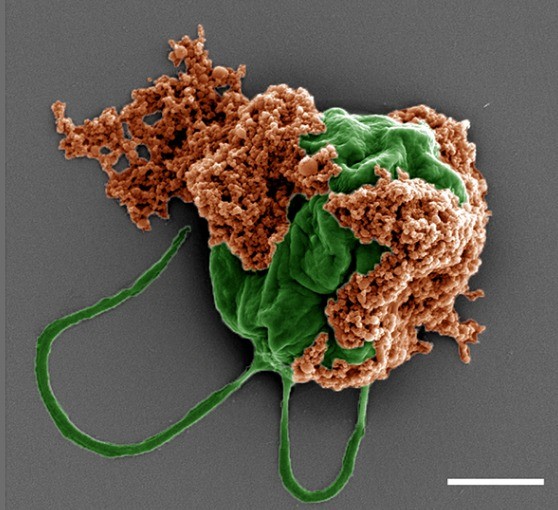Microrobots deliver medication to metastatic lung tumors in mice

Researchers have unveiled microscopic robots that can deliver chemotherapeutic drugs to metastatic lung tumors in mice.
Researchers from the University of California San Diego Jacobs School of Engineering (CA, USA) have engineered biohybrid robots that can deliver medication to lung tumors directly. Building upon a previous study conducted by the same researchers, this version of the microrobot has shown promise in mouse models of tumors that had metastasized to the lungs, demonstrating their efficacy in delivering medication that boosts mouse survival rates.

Figure 1. Colored scanning electron microscopy image of a microrobot: algae cell (green) covered with drug-filled nanoparticles (orange) coated with red blood cell membranes. Scale bar: 2 µm. Credit: Zhengxing Li (UC San Diego).
Similar microrobots were developed back in September 2022 for the treatment of bacterial pneumonia in mice. Now, the same team of researchers are adapting these microrobots to deliver cancer-fighting drugs to tumors, requiring a different drug and membranous coating to successfully combat the spread of cancer in the lungs.
The newly synthesized microrobots were created by attaching drug-filled nanoparticles to green algae cells, which enable the microrobots to efficiently move around in the lungs and deliver their nanoparticle payload to tumor sites (Figure 1). The nanoparticles themselves are constructed from tiny biodegradable polymer spheres, loaded with doxorubicin – a chemotherapeutic drug – and coated with the membranes of red blood cells to camouflage the nanoparticles from the immune system, allowing them to deliver their therapeutic payload without detection.
To test their microrobots, the researchers administered the chemotherapeutic microrobots to the lungs of mice with melanoma that had metastasized to the lungs via a tube inserted into the windpipe. Mice treated with the chemotherapeutic microrobot had a median survival time of 37 days, an improvement on the median survival time of untreated mice or mice that received either only the drug or only the nanoparticles without the algae, which was 27 days.

Who won the 2024 Kavli Prize for nanoscience?
Here, we present this year’s nanoscience award, shared by a trio of researchers whose work in nanoscale engineering has led to dramatic improvements in diagnostics, therapeutic delivery and bioimaging.
“The active swimming motion of the microrobots significantly improved distribution of the drug to the deep lung tissue, while prolonging retention time,” reported co-first author Zhengxing Li. “This enhanced distribution and prolonged retention time allowed us to reduce the required drug dosage, potentially reducing side effects while maintaining high survival efficacy.”
In the future, the team hopes to optimize these microrobots for use in larger animals, eventually bringing them to human clinical trials. Their previous development of microrobots that target bacterial pneumonia also shed light on the versatility of these robots and their potential: “We demonstrate that this is a platform technology that can actively and efficiently deliver therapeutics throughout the entire lung tissue to combat different types of deadly diseases in the lungs,” concluded Liangfang Zhang, co-senior author of the study.